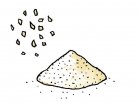In earlier times, Ouzo was prepared via a process that involved the double distillation of grape skins, along with the addition of various aromatics.
During the first distillation, these additives included aniseed and fennel seeds, while in the second they included ginger, cardamom, nutmeg, star-anise, mastic, cinnamon flowers, soapwort root, and barley, among many other ingredients. But today, such ouzo is no longer available on the market.
In recent years, the manufacturing of Ouzo has undergone many significant changes. For starters, the process no longer entails double distillation. Ordinary pure alcohol has replaced the liquor from grape skins. Similarly, either pure essential oils or synthetic preparations have replaced the myriad natural ingredients that were added during each distillation. Sugar is added to make ameliorate the potency and make the drink more palatable. In other words, the process has been dramatically simplified.
One thing that the new version does, in fact, have in common with the old, is the alcohol content. Over the course of three millennia, the drink has maintain an alcohol content that ranges between 40 and 45 %.
A second aspect that the two versions have in common is the clouding that occurs. Nevertheless, the clouding that took place in the original version was due to the separating of the ingredients that were not soluble in water, primarily the anise oil. The clouding of today's product is simply the result of the anethol separating, nothing more. Especially during the colder days, this separating can precipitate even without the addition of water. Sometimes, instead of clouding, small crystals will form within the drink.
































































